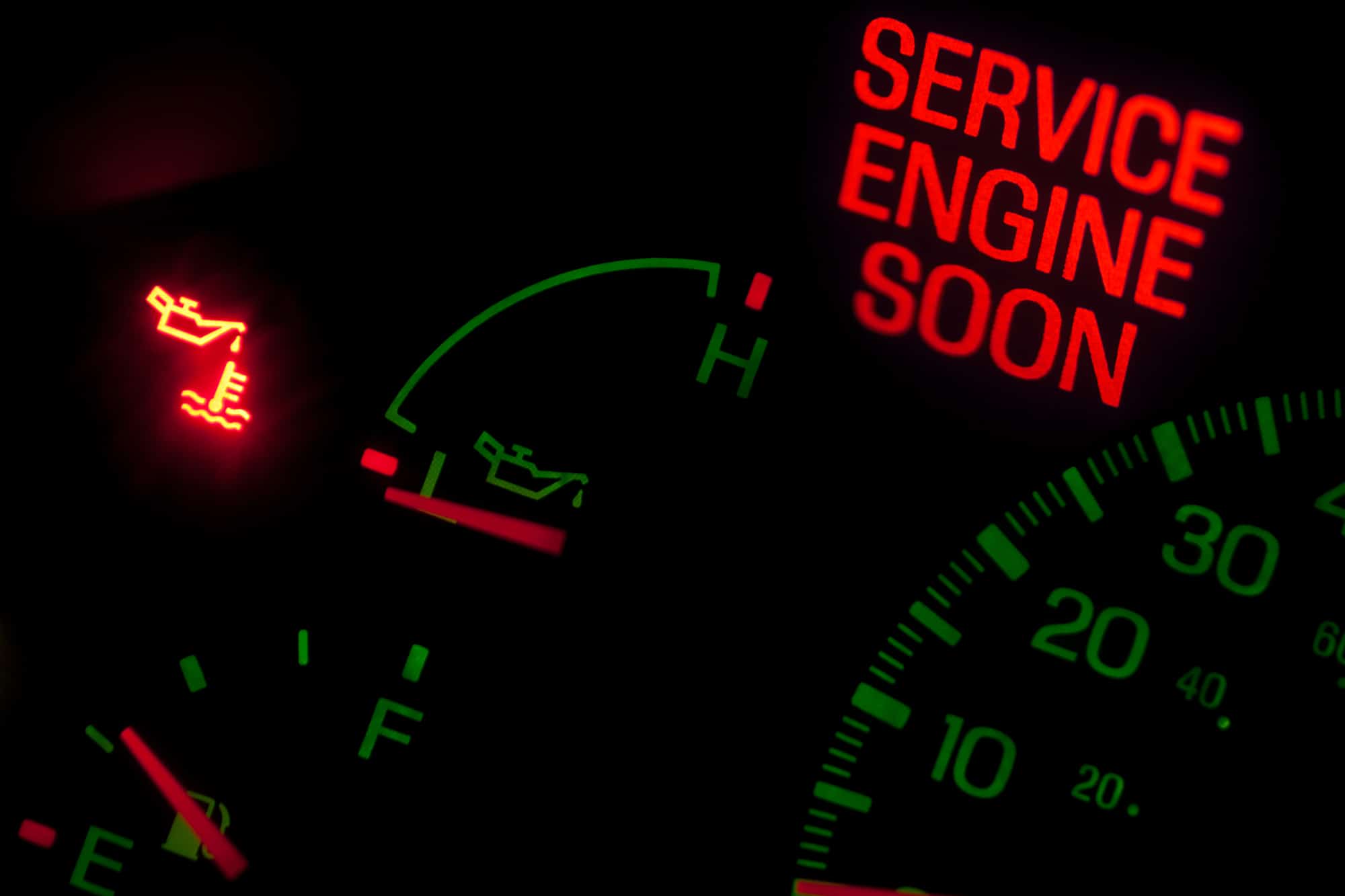As a general rule, yes, a coolant leak can sometimes cause low oil pressure. This usually occurs if coolant and engine oil mix within the engine as a result of a failed head gasket.
A simple coolant leak from a split hose or leaky radiator won’t usually affect oil pressure. Both the engine oil and coolant systems are separate sealed systems that usually don’t have any effect on each other. The only way low coolant can affect oil pressure is if the two systems start to mix.
Can low coolant affect oil pressure?
Low coolant can affect oil pressure if the engine oil is leaking into the coolant system within the engine. The most common cause of this type of leak is failed head gasket.
Sometimes low oil pressure can be caused by a problem with the oil pump or oil pressure sensor, so it’s important to check that these are working properly, even if the engine is losing coolant.
A low oil pressure warning can also be caused by a bad oil pressure sensor. The oil pressure sensor is usually located somewhere on the engine block. A faulty oil pressure sensor will give inaccurate oil pressure readings or may fail to give any readings at all.
What causes a coolant leak and low oil pressure?
A coolant leak with low oil pressure is usually caused by an internal leak in the engine that is allowing the coolant and engine oil to mix. This internal leak is often caused by a failed cylinder head gasket.
The head gasket is situated between the cylinder head and the engine cylinders. It seals the cylinders, preventing fuel or exhaust gases from escaping into the head of the engine, and also helps to create the pressure needed for combustion to occur. One of the most important functions of the head gasket is to allow engine oil and coolant to circulate within the engine without ever mixing.
A head gasket will fail if the engine overheats to the point that the engine block expands and sometimes warps. This can cause the head gasket to crack or split, thus losing its ability to seal the engine cylinders and stop engine oil from mixing with coolant.
Symptoms of a coolant leak that causes low oil pressure
The symptoms of a coolant leak within the engine that cause low oil pressure are the same as the symptoms of a blown head gasket.
1. Loss of coolant with no leaks
If your engine coolant levels are constantly dropping, but there is no sign of a leak, then the head gasket could be leaking or may have already failed. The head gasket is situated between the cylinder head and the engine block. Its job is to seal the combustion chambers and to separate the circulating engine oil from the coolant.
If the head gasket starts to fail this can lead to coolant entering the oil channels surrounding the combustion chambers, leading to a mix of engine oil and coolant. Unfortunately, this type of coolant leak is not easily detectable at first. Usually, the first sign of a failed head gasket is a loss of coolant without any obvious coolant leaks being present.
2. Engine overheating
Low engine coolant levels are a very common cause of engine overheating. As described above, loss of coolant is one of the first symptoms of a blown head gasket. When the coolant starts to leak into and mix with the engine oil this will cause an obvious drop in coolant level in the coolant reservoir. It will also cause an apparent increase in engine oil that may be noticeable if your car has a dipstick.
Most of the time a change to coolant or engine oil levels will go unnoticed as a leaky head gasket can occur quite quickly. Usually, the first signs of a failed head gasket will be an overheating engine followed by a drop in oil pressure.
How Can a Coolant Leak Impact Oil Pressure in a Vehicle?
A coolant leak, especially with water in coolant tank, can lead to a decrease in oil pressure in a vehicle. When the coolant leaks into the oil system, it can cause the oil to become diluted, reducing its lubrication properties and leading to a drop in oil pressure.
3. Coolant mixing with engine oil
Another common symptom of a coolant leak that causes low oil pressure is the presence of coolant in the engine oil. If the head gasket has failed at any point across the engine block then coolant will usually make its way into the engine oil that is lubricating the pistons and valves.
If enough coolant gets into the engine oil then this will drastically affect the lubricating properties of the oil that can lead to severe engine damage fairly quickly. It’s usually pretty easy to spot coolant that has mixed with engine oil. Removing the oil filler cap will often reveal a brownish/white milky substance on the back of the filler cap. On some vehicles, you may be able to see into the top of the engine and the cylinder head by shining a torch in the oil filler cap hole.
4. White smoke coming from exhaust
Continuous white smoke from the exhaust when driving can be a sign of a blown head gasket. It’s important to note the difference between white smoke that is only there on engine startup and white smoke that is emitted continuously when driving. White smoke on engine startup is a fairly common occurrence and can be caused by water vapor in the exhaust or an engine that is running rich on startup.
If the white smoke is caused by coolant leaking into the engine combustion chambers then it will be present when driving not just at startup up. There will also be a lot more white smoke than would otherwise be present and it may have a sweet smell caused by the coolant vapor in the smoke.
What next – How To Fix A Coolant Leak That Can Cause Low Oil Pressure?
If you suspect that your engine has an internal coolant leak then it’s very important to get to the bottom of it as quickly as possible, as a bad leak such as a complete head gasket failure will ruin the engine.
Here are a few things to check if your car is suffering from low oil pressure.
- Check the coolant level. The first thing to do if you suspect that there is a coolant leak is to check the coolant level. This is usually easy to do by simply checking the coolant level in the coolant reservoir bottle or radiator when the engine is cold. If the coolant level is low then top it up with the correct coolant mixture and take the vehicle for a short drive until the engine has warmed up to operating temperature. Check the coolant level again when the engine has cooled to see if it has dropped. Continute to monitor the coolant level over a few days (if it hasn’t dropped immediately) as this may indicate a slow leak.
- Run an engine diagnostic using an OBD-2 scanner. The next thing to do is to check the ECU for error codes that may point to a problem with the oil pump, the oil pressure sensor or the oil level sensor. A drop in engine oil pressure may sometimes be caused by a faulty oil pump or oil system sensor and may not be caused by a coolant leak. Error codes P0520 to P0524 indicate a problem with oil pressure when the engine is running and if any of these are present then you will need to check for a faulty oil pressure sensor or faulty oil pump.
- Check the condition and level of the engine oil. A very quick way to identify an internal coolant leak is to check the condition of the engine oil. If your car has a dipstick then start by dipping the oil. The dipstick will not only tell you if there is the right amount of oil present, but will also give you an indication of the color of the oil. If the engine oil is milky or has streaks of grey or white then it may indicate the presence of coolant. In this case, it’s important to drain the engine oil for a more thorough examination.
- Check for external coolant leaks. Not all coolant leaks or oil pressure problems are caused by a blown head gasket. If the coolant level is low then its always a good idea to start by checking for cracked coolant hoses and leaks from hose joints or from the radiator. Most coolant leaks are external leaks where the coolant leaks from the engine onto the pavement. Its important to rule out such a leak before moving onto more serious causes of coolant loss.
As an Amazon Associate we earn from qualifying purchases.











I noticed my car’s engine oil has a milky appearance, does this always mean my head gasket is failing, or could there be other reasons for this symptom?
How can I determine if the coolant in my engine is actually mixing with the oil, beyond just looking for a milky substance on the dipstick or under the oil filler cap?